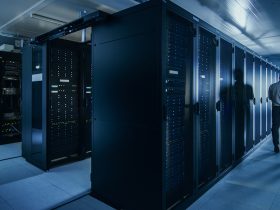In today’s interconnected world, cybersecurity has become a non-negotiable aspect of running any business. The rapid shift to digital, combined with the increasing sophistication of cyberattacks, means that organizations must not only adopt cybersecurity measures but also continuously refine them to stay ahead of emerging threats. For businesses, from startups to industry giants, building a robust cybersecurity framework is paramount to safeguarding sensitive data, maintaining client trust, and ensuring compliance with industry regulations. This guide provides a comprehensive introduction to cybersecurity essentials employed by top companies to protect their digital assets.
1. Understanding the Importance of Cybersecurity
Before diving into specific cybersecurity tools and practices, it’s essential to understand why top companies prioritize cybersecurity. The cost of a breach is steep—ranging from financial losses to reputational damage and legal liabilities. Cybercriminals are constantly evolving their tactics, using methods like phishing, ransomware, and social engineering to target vulnerabilities. In fact, according to a 2024 report from IBM, the average cost of a data breach is over $4 million. This is why top companies don’t just react to threats; they proactively implement comprehensive cybersecurity strategies that evolve as the digital landscape changes.
2. Building a Strong Foundation with Risk Assessment
Top companies start their cybersecurity journey by conducting thorough risk assessments. This process involves identifying potential threats, vulnerabilities, and the impact of these risks on the organization. By understanding which assets are most at risk—whether it’s customer data, intellectual property, or internal systems—companies can prioritize their security efforts more effectively.
Risk assessments help organizations understand the scope of potential threats, allowing them to allocate resources efficiently and implement the right security measures. For example, a company might identify that its cloud storage is a critical vulnerability, prompting them to invest in more robust cloud security measures or encryption tools.
3. Implementing a Multi-Layered Defense Strategy
The most effective cybersecurity strategies are multi-layered. A multi-layered approach ensures that if one defense mechanism fails, others are in place to protect critical systems and data. Top companies deploy a combination of preventive, detective, and corrective measures to create layers of security across their networks.
Firewalls and Intrusion Detection Systems (IDS) are the first line of defense, blocking unauthorized access and monitoring traffic for suspicious activity. Next, Endpoint Protection is deployed on all devices connected to the company network. This might include anti-malware, encryption, and device management software. If an attacker manages to bypass the initial defenses, intrusion detection and prevention systems (IDPS) can detect unusual behavior in real-time, providing another layer of protection.
Top companies also invest in Virtual Private Networks (VPNs) for secure remote access and Zero Trust Architecture (ZTA), where no device or user is trusted by default, even if they are inside the corporate network. With ZTA, authentication and verification are required for every access attempt.
4. Employee Training and Awareness
Human error remains one of the leading causes of cyber breaches. A well-trained workforce is a critical line of defense, which is why top companies emphasize employee cybersecurity awareness. Phishing attacks, for example, often succeed because employees unknowingly click on malicious links or provide sensitive information to attackers pretending to be trusted entities.
To mitigate this risk, companies invest in regular security awareness training programs. These programs teach employees how to recognize phishing emails, create strong passwords, and follow safe online practices. Simulated phishing attacks are often conducted to test and reinforce the training, helping employees recognize real threats in a controlled environment. Training extends to contractors and third-party vendors as well, ensuring that everyone connected to the organization understands and follows security protocols.
5. Strong Authentication Mechanisms
Authentication mechanisms are a fundamental part of securing access to systems and sensitive data. Top companies use Multi-Factor Authentication (MFA) as a standard practice to verify users’ identities. MFA adds an extra layer of security by requiring more than just a password to access an account. Typically, this involves something the user knows (password), something the user has (a mobile device or hardware token), or something the user is (biometrics such as fingerprints or facial recognition).
For critical systems or high-level access, companies may also implement Role-Based Access Control (RBAC). This ensures that employees only have access to the systems and data necessary for their role, reducing the risk of internal threats and limiting the damage in case of a breach.
6. Data Encryption: Securing Information Both In-Transit and At-Rest
Data is a prime target for cybercriminals, which is why top companies employ encryption to protect sensitive information. Encryption converts data into an unreadable format, ensuring that only authorized individuals with the decryption key can access it. This is essential for protecting both data in transit (such as when it’s sent over the internet) and data at rest (stored data, such as databases and files).
Encryption is particularly important for organizations handling personally identifiable information (PII), financial records, or intellectual property. Many industries, such as healthcare and finance, are legally required to encrypt certain types of data to comply with regulations like HIPAA or PCI-DSS.
7. Regular Software Updates and Patch Management
Vulnerabilities in software and hardware are common entry points for cyber attackers. Companies that fail to regularly update and patch their systems leave themselves open to exploitation. Top companies have rigorous patch management processes in place to ensure that software vulnerabilities are addressed promptly. This includes automating updates where possible and conducting regular audits to ensure all systems are up-to-date.
Security patches are released by software vendors to fix known vulnerabilities. Failure to apply these patches in a timely manner can lead to security breaches. To combat this, top companies automate patch deployment and continuously monitor systems to ensure they remain secure against the latest threats.
8. Incident Response and Disaster Recovery Plans
No cybersecurity strategy is complete without a well-defined Incident Response Plan (IRP) and Disaster Recovery Plan (DRP). These plans outline the steps the company will take in the event of a security breach or system failure.
An IRP helps ensure that a breach is contained, investigated, and remediated as quickly as possible, while a DRP focuses on restoring business operations in the event of a system failure or cyberattack. For example, in the case of a ransomware attack, the company would follow its incident response protocol to contain the attack and work with law enforcement, while the disaster recovery plan would help restore systems from backups.
Top companies regularly test and update these plans through simulated cyberattacks (also known as tabletop exercises) to ensure they can respond effectively to real-world incidents.
9. Compliance with Legal and Regulatory Standards
Companies must comply with various legal and regulatory standards regarding cybersecurity, depending on their industry. Regulations like General Data Protection Regulation (GDPR), Health Insurance Portability and Accountability Act (HIPAA), and Payment Card Industry Data Security Standard (PCI-DSS) set strict guidelines on data protection and security.
Top companies make compliance a priority, understanding that non-compliance can result in hefty fines, legal ramifications, and reputational damage. Compliance isn’t just about avoiding penalties; it also strengthens the company’s overall security posture by adhering to best practices that have been proven to reduce the risk of cyber threats.
10. Continuous Monitoring and Threat Intelligence
The cybersecurity landscape is constantly changing, and threats evolve rapidly. To stay ahead, top companies rely on continuous monitoring and threat intelligence services. These tools help detect and respond to threats in real time, identifying potential vulnerabilities before they can be exploited.
Threat intelligence provides insights into the tactics, techniques, and procedures (TTPs) of known attackers, allowing companies to proactively defend against emerging threats. Real-time monitoring allows companies to identify suspicious activities across their network and take action before a breach occurs.
Conclusion: A Holistic Approach to Cybersecurity
In conclusion, the cybersecurity essentials employed by top companies are multifaceted, involving a combination of technical solutions, employee education, and strategic planning. By implementing a layered approach to cybersecurity—ranging from strong authentication practices to incident response plans—businesses can effectively mitigate the risks posed by cyber threats. As the digital landscape continues to evolve, companies must remain vigilant, continuously updating their security protocols to protect against emerging threats. By making cybersecurity a top priority, businesses can safeguard their assets, maintain customer trust, and thrive in an increasingly digital world.









